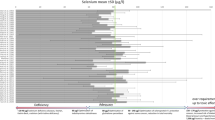Abstract
The selenium concentration in foods grown and consumed and in plasma, red blood cells, and toenails of people living in the district of Chita in the transbaikalian part of Russia were studied in August 1991. Preliminary results from the area have suggested low selenium intakes and the possible occurrence of cardiomyopathy (Keshan disease) in the population. A low selenium concentration in foods grown locally was found: mean selenium concentration in wheat grains was 1, 5, and 28 μg/kg, respectively, in three villages studied, that of oats was beween 3–6 μg/kg, and of cow's milk 10–27 μg/kg dry matter. The selenium concentration of bread was considerably higher, between 87–337 μg/kg dry wt, presumably because wheat imported from the US had been used for baking. Occasional samples of pork, beef, and mutton contained between 32–318 μg selenium/kg dry wt. Low selenium concentrations were observed in samples of soil and river water. The mean plasma selenium concentration of 52 persons was 1.02 μmol/L, including 33 children and 19 adult subjects. The selenium concentrations in red blood cells and toenails were 1.95 μmol/L and 0.61 mg/kg, respectively. No symptoms of heart disease caused by selenium deficiency were observed. It is concluded that the selenium status of people was fairly good thanks to the contribution to dietary intake of imported wheat with a high selenium content. As the selenium concentration was very low in foods grown in the area, the selenium intake of the population will be reduced to a very low level if only locally produced foods are consumed.
Similar content being viewed by others
References
Keshan Disease Research Group of the Chinese Academy of Medical Sciences,Chinese Med. J. 92, 461 (1979).
X. Chen, G. Yang, T. Chen, X. Chen, Z. Wen, and K. Ge,Biol. Trace Elem. Res. 2, 91 (1980).
C. D. Thomson and M. F. Robinson,Am. J. Clin. Nutr. 33, 303 (1980).
C. D. Thomson and M. F. Robinson,Am. J. Clin. Nutr. 33, 303 (1980).
P. Varo and P. Koivistoinen,Acta Agric. Scand. Suppl. 22, 165 (1980).
G. F. Combs and S. B. Combs, inThe Role of Selenium in Nutrition, Academic Press, NY, pp. 1–387 (1984).
J. H. Watkinson,Am. J. Clin. Nutr. 34, 936 (1981).
M. Mutanen, and P. Koivistoinen,Int. J. Vit. Nutr. Res. 53, 102 (1983).
V. V. Ermakov,Biol. Trace Elem. Res. 33, 171 (1992).
V. N. Ivanov, A. V. Voshchenko, T. I. Obukhova, T. V. Borisova, I. V. Samoilenko, T. N. Perifilyeva, T. P. Tarainova, and G. A. Voshchenko, inSymposium Abstracts. Trace Eleemnts in Human Health and Disease. Second Nordic Symposium, K 16, Odense (1987).
J. Kumpulainen and K-E. Saarela,J. Anal. Atom. Spectrom. 7, 165 (1992).
J. Kumpulainen, A-M. Raittila, J. Lehto, and P. Koivistoinen,J. Assoc. Off. Anal. Chem. 66, 1129 (1982).
R. Tahvonen and J. Kumpulainen,Fresenius J. Anal. Chem. 345, 240 (1993).
J. Kumpulainen and M. Paakki,Fresenius J. Anal. Chem. 326, 684 (1987).
G. Alfthan and J. Kumpulainen,Anal. Chim. Acta 140, 221 (1982).
M. Ihnat, Y. Thomassen, M. S. Wolynetz, and C. Veillon,Acta Pharmacol. Toxicol. 59 (suppl 7), 566 (1986).
G. Alfthan,Anal. Chim. Acta 165, 187 (1984).
D. Wang, G. Alfthan, A. Aro, L. Kauppi, and J. Soveri, inTrace Elements in Health and Disease, A. Aitio, A. Aro, J. Järvisalo, and H. Vainio, eds., Royal Society of Chemistry, Cambridge, England, pp. 49–56 (1991).
G. Alfthan, A. Aro, H. Arvilommi, and J. K. Huttunen,Am. J. Clin. Nutr. 53, 120 (1991).
G. Yang, J. Chen, Z. Wen, K. Ge, L. Zhu, X. Chen, and X. Chen,Adv. Nutr. Res. 6, 203 (1984).
G. Alfthan,Nutr. Res. 8, 467 (1988).
E. B. Thorling, K. Overvad, and J. Geboers,Ann. Clin. Res. 18, 3 (1986).
G. Alfthan, G. Bogye, A. Aro, and J. Feher,J. Trace Elem. Electrolytes Health Dis. 6, 233 (1992).
J. Neve, J. Vertongen, and L. Molle,Clin. Endocrinol. Metab. 14, 629 (1985).
Author information
Authors and Affiliations
Rights and permissions
About this article
Cite this article
Aro, A., Kumpulainen, J., Alfthan, G. et al. Factors affecting the selenium intake of people in transbaikalian Russia. Biol Trace Elem Res 40, 277–285 (1994). https://doi.org/10.1007/BF02950800
Received:
Accepted:
Issue Date:
DOI: https://doi.org/10.1007/BF02950800




